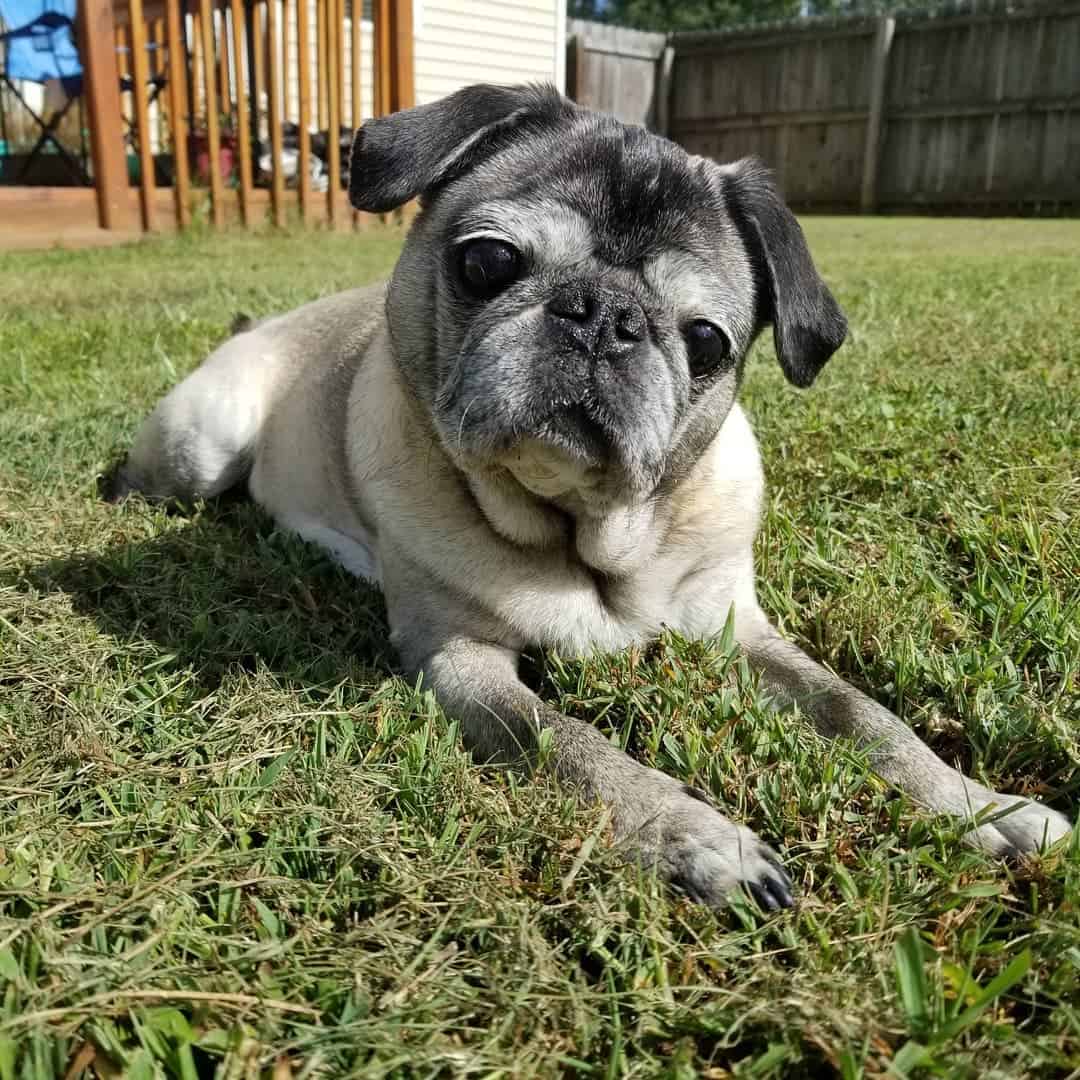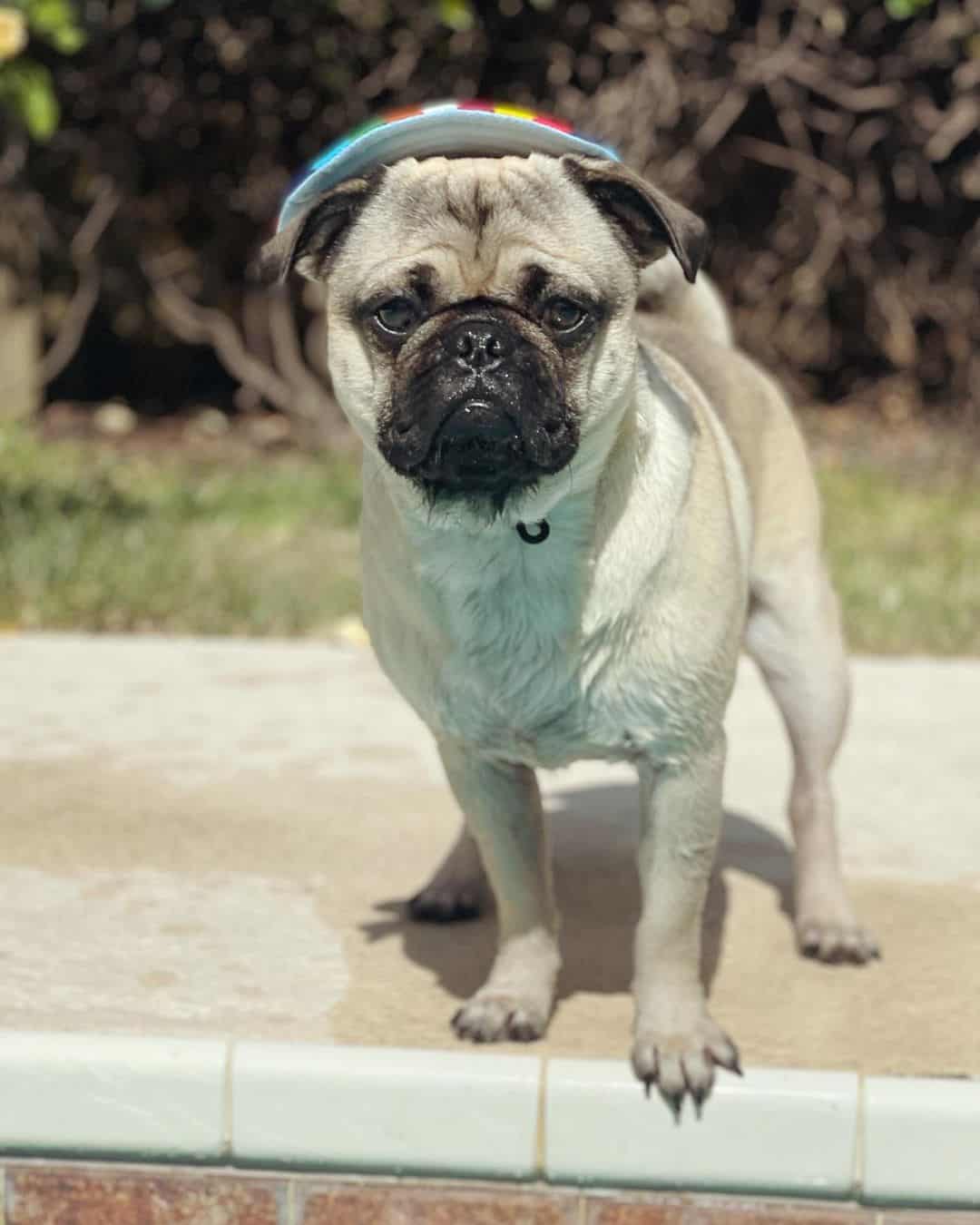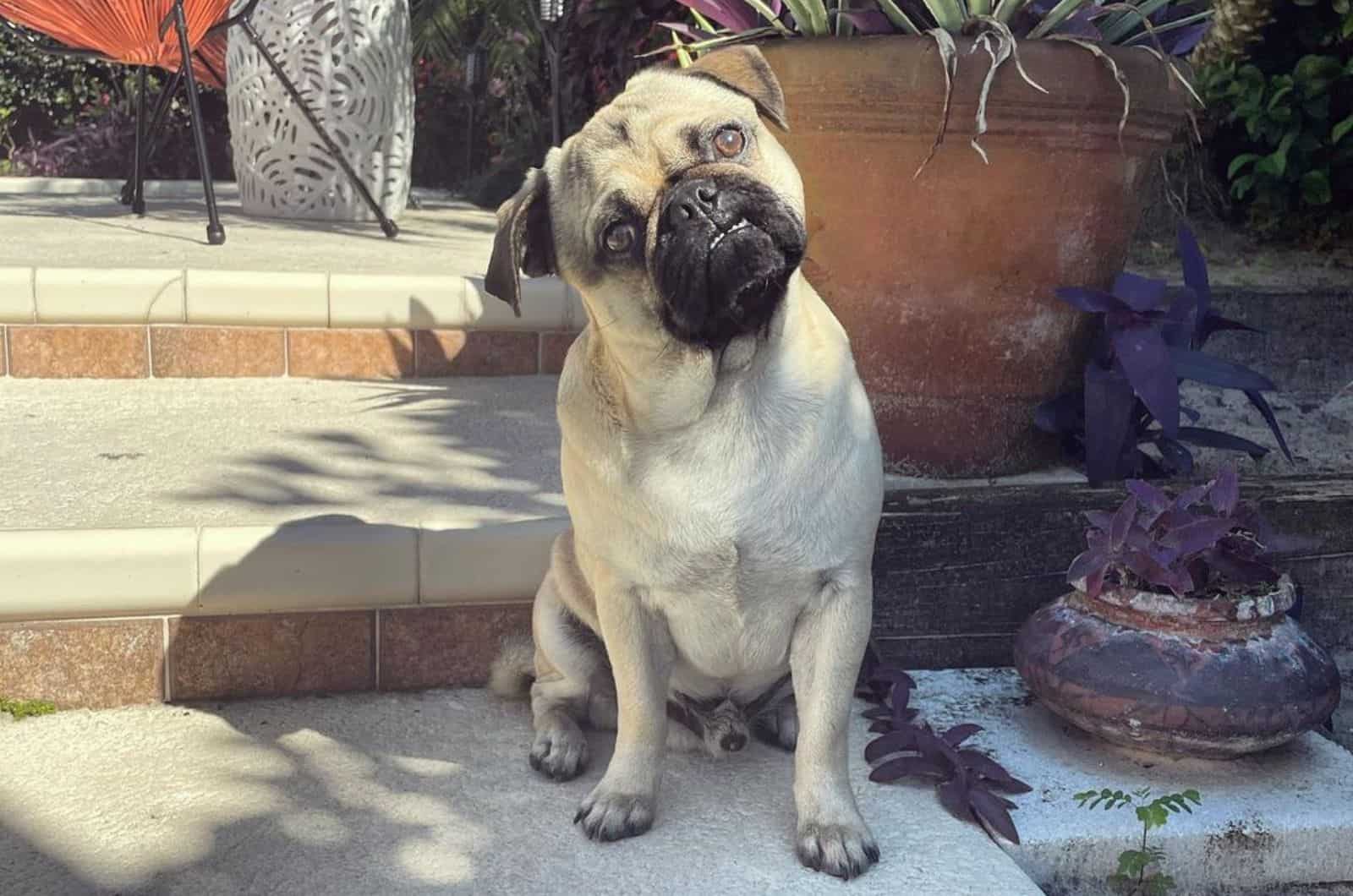Have you ever heard about the silver fawn Pug? If this sounds vaguely familiar, but also kind of weird, that’s because this is actually a very special type of Pug.
The silver fawn Pug is a particular variation of the classic fawn Pug, which is itself one of only two standard colors approved by the American Kennel Club (AKC), the other one being the black Pug.
The fawn Pug comes in a variety of coat colors, including silver. The AKC states that there is no specific category for silver fawn Pugs; instead, they will be classified under fawn Pugs.
However, if we go by the Federation Cynologique Internationale (FCI), then there are four colors in total: silver, apricot, fawn, and black. As you can see, the FCI lists the silver Pug as a separate color.
The purpose of this article is to delve deep into the topic of silver fawn Pugs and explain how different from, and how similar to, other types of Pug it is.
So let’s get started!
What Is A Silver Fawn Pug

As we’ve already said, the silver fawn Pug is actually just a variation of the fawn Pug.
Fawn Pugs are available in a variety of colors, including standard fawn, apricot fawn, and silver fawn. They continue to be the same breed of dog, nevertheless. These hues are merely used to describe the fur color and tint.
Compared to the standard and apricot fawn Pugs, silver ones are substantially lighter in color.
Origin Of The Silver Fawn Pug
Since the silver fawn Pug is not an actual breed in its own right — and not even an official subtype of Pug, by some accounts — there is no real breed history to be talked about.
Instead, its origins are linked to the Pug breed in general. That means that we cannot talk about the silver fawn Pug without first covering the rich history of the beloved Pug breed of dog.
Pug Breed History
It is generally accepted that the purebred Pug is thought to have its origins in China, then traveled to Japan and eventually, Europe.
The Happa, a smooth-coated Pekingese-like dog breed that is frequently spelled “Ha-pa,” has been around in China for a very long time. In fact, many people believe the Happa might have been the Pug’s ancestor.
The Shakespearean term for an impish countenance, “pug” or “pugge,” was also employed as a name of affection.
However, it can also be that it’s a derivative of the word “puck.”
In any case, the name of the breed was meant to signify its size and unique appearance.
In China, where they were frequently honored in a manner resembling monarchy, certain dogs were even granted titles of status. They were closely observed, and many of them had attendants who looked after them and made sure they were as comfortable as possible.
Given that the dogs were typically viewed primarily as ornaments, it makes it natural that the majority of Pug owners were members of the nation’s governing classes or those in Court circles.
Before reaching the West, the Pug was well-known in Asia, and it appears that on the road to Europe, it passed through Russia.
Read next: Comeback Of The Retro Pug
Interestingly, they have a Latin motto associated with them, saying “multum in parvo,” which literally means “a lot in a little.” Sounds about right!
How Did The Silver Fawn Pug Come About?
There are two officially recognized, and very distinct, Pug coat colors. Those two colors are black and fawn.
Both of them seem to be as old as the breed itself, and as time progressed, there have been a lot of slight variations of the hues, particularly with the fawn Pugs.
Given that they traveled a lot during their history, and therefore were exposed to many different climates and surroundings, their coat naturally adapted, and it makes perfect sense that there would be some alternations in the coat color.
Therefore, some fawn Pugs have slightly darker shades in their coat, others are somewhat lighter, and there are even those with some sporadic undertones or white markings, particularly around the face and neck.
One of those variations is the silver fawn Pug, which is considered to be the lightest-coated Pug of them all. There are cases where they are so light that they are almost white, which is why some people tend to mistake them as a distinct coat color in their own right.
However, they are not. They are just a very, very, very light shade of fawn.
Is The Silver Fawn Pug Recognized By The AKC?
Fawn Pugs come in variations with silver or deep apricot tones, as was already described. Fawn is a general term, thus some major kennel clubs classify them as fawn-colored dogs while others distinguish them as apricot Pugs or silver Pugs.
Apricot fawn-coated Pugs have a medium cream appearance that is darker than a fawn Pug’s appearance. The lightest color is found in silver fawn Pugs, who typically have exceptionally pale coats with a silver tinge.
Three Pug colors are accepted by the Canadian Kennel Club: silver fawn, fawn, or black. The term “fawn” can, however, refer to any shade of fawn, including light or dark apricot fur hues, in Canada.
The Kennel Club of the UK, just like the previously mentioned FCI, accepts four coat colors, which are silver, apricot, fawn, and black Pugs.
Silver fawn Pugs are not eligible to participate in show rings.
Silver Fawn Pug Appearance

One of the main distinctive traits of Pugs is their unique appearance. There is basically no chance that you will mistake them for another breed when you see them in the street.
However, are there any unique visual traits that separate the silver fawn Pug from the other types of Pugs?
Well, aside from their coat color, not really. All Pugs look alike when it comes to their size, build, and facial structure. The only thing that really makes them stand apart is their coat color variations.
But that being said, we should still try to describe their appearance in more detail.
Silver Fawn Pug Coat
These pugs have a very light shade and are actually the pugs thought to have the lightest coat of any Pug. Some people tend to think of them as a separate coat color in their own right because they can occasionally be so pale that they are almost white.
Silver fawn Pugs have double coats, despite the fact that their hair is so short that it often looks like they have a single coat.
However, do not be fooled by the short, silky coat. Silver fawn Pugs shed a lot, especially during the summer.
Silver Fawn Pug Size
As we said, silver fawn Pugs do not differ from the breed standard when it comes to their appearance, and that includes height and weight.
Silver fawn Pugs, although having sturdy exteriors, belong to the toy category. They weigh between 14 and 18 pounds, and their height varies from 10 to 11 inches.
They are large, square dogs with thick limbs.
Other Physical Traits Of The Silver Fawn Pug
Their heads have their distinctive deep wrinkled short, flat muzzle with the trademark black mask. Their large, dominating eyes convey a variety of feelings, from surprise and happiness to curiosity, and they overshadow their goofy, wrinkly face.
They have “beauty spots,” or moles, on their cheeks, and a distinct “thumb mark” on their forehead. Additionally, some non-black Pugs, including silver fawns, can have a higher amount of black hairs located on their coat, which is described as smuttiness.
Silver Fawn Pug Personality

Pugs were developed as companions, and they excel at providing companionship. The Pug gets quite upset if his loyalty isn’t reciprocated and demands quite a bit of attention and affection.
They are typically sedentary dogs and are pleased to curl up on the couch with you while you’re watching a movie or reading a book.
This does not imply that the Pug is a passive dog. On the contrary, they can be humorous, energetic dogs that love to party and entertain their owner with ridiculous antics.
Numerous elements, including training, socialization, and genetics, have an impact on temperament. Puppies with good dispositions are interested and playful, approachable, and want to be cuddled.
Like any dog, Pugs require early socialization, as well as being exposed to a variety of sights, noises, and experiences when they are young. In order to guarantee that your silver fawn Pug puppy develops into a well-rounded dog, socialization is important.
Are Silver Fawn Pugs Good Family Pets?
Silver fawn Pugs are wonderful companions for kids since they are playful and adaptable to almost any living situation.
Due to their small size, these spirited and hardy little dogs make excellent family pets and are a suitable option for households with smaller children.
However, silver fawn Pugs should always be under supervision when around children, just like with any breed, to ensure everyone’s safety and happiness.
Are Silver Fawn Pugs Aggressive?
Pugs are generally playful and versatile and are not thought of as an aggressive breed.
However, silver fawn Pugs, like other small breeds, can be quickly startled, and if your dog feels threatened or worried, aggressive behaviors like barking and nipping may appear.
When out and about, a dog with good socialization skills will be confident, affable, and less likely to display undesired hostility.
Silver Fawn Pug Health

As you might have already known, Pugs aren’t exactly the healthiest dog breed out there. Due to their unique physiology, brachycephalic head shape, and genetics, they are prone to a number of various medical conditions, some of them more serious than others.
Silver fawn Pugs are susceptible to a range of skin disorders, such as demodectic mange, staph infections, and yeast infections.
Although their large, black eyes are endearing, they are particularly weak and prone to health issues. Pugs can occasionally suffer from proptosis, dry eyes, and corneal ulcers, among other conditions.
Your veterinarian must treat skin disorders like walking dandruff, which is brought on by a tiny mite. Pug owners must also keep an eye on their dogs’ weight because it can make their breathing issues worse.
All this being said, silver fawn Pugs can still lead a happy and healthy life, as long as you keep a close eye on their health and take them for checkups with the vet regularly.
Most of the time, catching an issue early and nipping it in the bud will keep your Pug in optimal health.
Common Health Issues In Silver Fawn Pugs
Silver fawn Pugs are susceptible to some health issues like all breeds. Even though not all silver fawn Pugs may contract any or all of these illnesses, it’s still vital to be aware of them if you’re thinking about getting one.
To better assist you to understand some of the health issues we find more frequently in Pugs than in other dog breeds, we’ve included some of the more prevalent ones.
By selecting a reputable breeder when purchasing a puppy, you can improve your chances of getting a contented and healthy dog.
Below are some of the health problems that are known to affect Pugs as a breed, and therefore silver fawn Pugs, as well.
Epilepsy
Idiopathic epilepsy, which is common in Pugs, leads them to experience seizures for no apparent reason. Take your silver fawn Pug to the vet if it experiences seizures so they can identify the best course of action.
Cheyletiella Dermatitis
This skin ailment is brought on by a tiny mite.
Contact your veterinarian if you notice a lot of dandruff, particularly in the middle of the silver fawn Pug’s back. All household pets must be treated since the mites that cause this illness are contagious.
Pug Dog Encephalitis
The fatal inflammatory brain condition known as PDE only affects Pugs.
There is no way to diagnose or treat this ailment in Pugs, and doctors are unsure of why it occurs. Only after the dog has passed away can tests be performed on its brain tissue to determine whether it has had PDE.
Young dogs are typically affected by PDE, which results in seizures, circles, blindness, coma, and death. This may take a few days or even weeks to occur.
The Pug Dog Club of America and the American Kennel Club Canine Health Foundation are funding research initiatives to try and understand more about PDE because it appears to have a genetic component.
Patellar Luxation
Anatomical portion dislocation is referred to as luxation.
Patellar luxation is a painful condition in which the knee joint (often of the back leg) slides in and out of place. Although it can be disabling, many dogs with this condition live relatively normal lives.
Nerve Degeneration
Older Pugs with nerve degeneration may drag their hindquarters, stagger, have problems jumping up or down, or become incontinent.
Silver fawn Pugs who have this ailment don’t seem to be in discomfort, and it typically worsens gradually.
Why it happens is a mystery to researchers. Some owners purchase carts for their Pugs to assist them to move around because their front legs are frequently still strong, and the veterinarian may be able to give medicine to aid with symptoms.
Hip Dysplasia
Both small and large breeds, including Pugs, are afflicted by this disease.
It is believed that a variety of factors, including nutrition, environment, and genetics, are responsible for this hip joint malformation. With the right veterinary care, affected Pugs typically enjoy normal, healthy lives.
Allergies
Numerous allergies, ranging from contact to food allergies, affect some Pugs.
If your silver fawn Pug is excessively licking its paws or touching its face, assume an allergy and have your veterinarian examine him.
Demodectic Mange
All dogs carry little companions known as a demodex mites, sometimes known as demodicosis. In the first few days after birth, the mother dog infects her puppies with this mite.
Only the mother may transmit the mite to her pups; it cannot be spread to people or other dogs.
Demodex mites are found in hair follicles and are typically not a concern. But your silver fawn Pug may develop demodectic mange if its immune system is weakened or damaged. Demodectic mange can be specific to one area or widespread.
It is regarded as a puppy ailment and frequently goes away on its own.
However, you should still take your dog to the vet because demodectic mange can develop into its generalized version. Older puppies and young adult dogs are more susceptible to generalized demodectic mange, which affects the entire body.
Over its entire body, the dog develops skin infections, bald areas, and patchy skin.
According to the American Academy of Veterinary Dermatology, dogs who get widespread demodectic mange should be neutered or spayed, as there is a genetic relationship.
Legg-Perthes Disease
This condition also affects the hip joint and is prevalent in several toy breeds.
The blood flow to the head of the femur, which is the huge back leg bone, is reduced in a Pug with Legg-Perthes, and the part of the femur that attaches to the pelvis starts to deteriorate.
The initial symptoms of Legg-Perthes, including limping and muscular atrophy in the leg, typically appear in puppies between the ages of 4 and 6 months.
The issue can be treated surgically by removing the diseased femur from the body so that it is no longer connected to the pelvis. The surgical scar tissue creates a false joint, and the puppy is typically pain-free as a result.
Staph Infection
Staph bacteria are frequently found on the skin, but certain dogs who experience immune system stress may get pimples and infected hair follicles.
Where there is hair, the lesions can resemble hives; where there is no hair, they can resemble ringworm. If you notice this on your silver fawn Pug, you should speak with your veterinarian to receive the proper care.
Yeast Infection
Your silver fawn Pug can have a yeast infection if it smells awful, itches, and develops thick, darkened skin.
It frequently affects the neck, inside of the ears, groin, feet, and armpits. To resolve this, your veterinarian may prescribe medication.
Hemi-vertebrae
Misshaped vertebrae can occur in short-nosed breeds like French Bulldogs, Bulldogs, and Pugs.
In other cases, only a few vertebrae are impacted, allowing the dog to lead a normal life. Between the ages of 4 and 6 months, some will stagger and exhibit an unsteady, weak walk.
Some dogs’ conditions worsen over time and can possibly result in paralysis. The condition’s origin is not known. Surgery may be beneficial.
Corneal Ulcers
The Pug’s eyes are large and prominent, making them vulnerable to injury and corneal ulcers.
Contact your vet right away if your Pug squints or if its eyes are abnormally bloodshot and weeping. When treated, corneal ulcers typically improve, but if untreated, they can rupture the eye or even result in blindness.
Dry Eye
Pugs can develop pigmentary keratitis and keratoconjunctivitis sicca. They could happen all at once or separately.
When the eyes don’t produce enough tears to stay moist, dry eye is the result. If this is the cause, your veterinarian can run tests to see if it can be treated with medicine and extra care.
Black dots on the cornea are a symptom of pigmentary keratitis, especially in the region next to the nose. Blindness may result if the pigment completely encases the eye.
Medication that will assist keep your silver fawn Pug’s eyes moist and remove the pigment can be prescribed by your veterinarian. Both of these eye conditions call for ongoing treatment and attention.
Silver Fawn Pug Lifespan
The life expectancy of a silver fawn Pug is the same as any other Pug, as the coat color does not affect health or longevity in any way.
The typical lifespan of a Pug is 12 to 15 years. Some Pugs can live much longer than that; some have even reached lifespans of around 20 years. However, many Pugs don’t live past the age of 15 due to their propensity to put on weight quickly and general respiratory problems.
Similar to many other animal species, most female Pugs live longer than male Pugs. Given their numerous breathing issues, most Pugs prefer to live in cooler regions.
Is The Silver Fawn Pug Rare?

Silver fawn Pugs are rather uncommon, and many owners classify them as fawns rather than silver fawns.
However, since they are most often classed as a subcategory of fawn Pugs, they are not the rarest type of Pug.
Fawn is, of course, the most common Pug color, and it comes from combining two recessive genes. On the other hand, black Pugs can be formed by just one gene, which is why it’s often called the black gene.
There are some different colors and patterns that are even less common and typically not recognized as up to the breed standard by the American Kennel Club.
Other Rare Pug Colors
The other pug colors that exist, besides fawn, black, silver, and apricot, are sometimes labeled as exotic or trendy. Most of the time, they are not officially accepted by the American Kennel Club as they are not considered to match the breed standard.
Those alternate colors and patterns include chocolate Pugs, panda Pugs, brindle Pugs, white Pugs, merle Pugs, as well as black and tan Pugs.
Brindle, for example, is more common in Boston Terriers (and occasionally Shih Tzus), so if you see a brindle Pug, it is highly likely that they have some Boston Terrier blood somewhere in their DNA.
Silver Fawn Pug Price

Fawn Pugs are priced similarly to other Pugs because it is one of the typical colors for this breed. Fawn Pugs typically cost between $600 and $1500, but depending on the pedigree and breeding rights, they can cost as much as $6,000 or more.
However, since silver fawn Pugs are considered to be special by some people — and they are definitely rarer — they can occasionally command a higher-than-average price.
Of course, there are multiple factors that affect the cost of any puppy, and it’s important that you do your research beforehand and that you only buy a silver fawn Pug puppy from a respectable breeder that you trust.
You should also ask them about the puppy’s parents, their bloodline and general health, as this can usually be a good indicator of the pup’s future health.
Conclusion
The fawn Pug comes in a variety of coat colors, including silver. The American Kennel Club states that there is no specific category for silver fawn Pugs; instead, they will be classified under fawn pugs.
If they have perhaps seemed mysterious and fascinating to you before, we hope that this article has shed some light on this adorable little Pug variation.
We have aimed to cover all the facets of the silver fawn Pug that make them distinctive, but also the ones that show that it’s nevertheless the exact same breed as the regular fawn Pug.
All in all, it’s a very interesting dog that will surely win over your heart if you choose to adopt one. If you decide to do so, make sure that you research all the Pug breeders available to you and select the best one.
